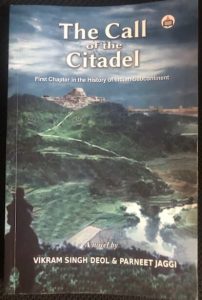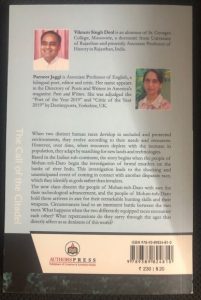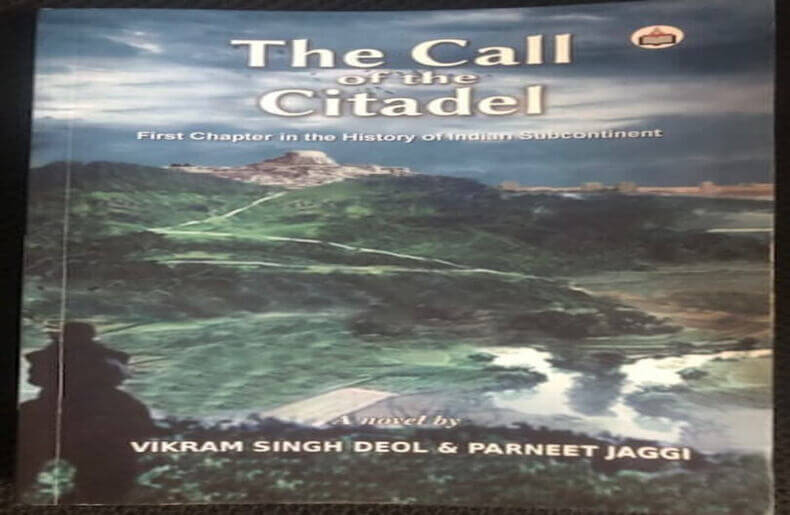Reading Time: 6 minutes
Gopal reviews a debut novel, by Vikram Singh Deol & Parneet Jaggi, The Calls of the Citadel, exclusively for Different Truths.
Book: The Call of the Citadel
Authors: Vikram Singh Deol & Parneet Jaggi
Authorspress, New Delhi, Pp- 180, INR-230/-
The Call of the Citadel, the debut novel, written by Vikram Singh Deol and Parneet Jaggi focusses on the conflict between two races for the supremacy, in an imaginary locale somewhere in the Indian sub-continent. In a fascinating look at war, heroism, and humanity that transcends geography, nationality, and time, this book has luminous prose that we have not seen often — an ecstasy of a delirious sort of love for what they observe and that is well enough for fresh ideas. The result is a historical fiction that makes startlingly plain how civilisations are so often destined to repeat themselves, be it through survival, ambition, struggle or desire.
In a fascinating look at war, heroism, and humanity that transcends geography, nationality, and time, this book has luminous prose that we have not seen often — an ecstasy of a delirious sort of love for what they observe and that is well enough for fresh ideas. The result is a historical fiction that makes startlingly plain how civilisations are so often destined to repeat themselves
“The crowd erupted in cheers; their voices carried over too far off distances by the soft breeze. The prisoners looked at the citadel, and as the noise moved further into the jungle, the people of Mohan-toh-Daro heard. They shifted uneasily and looked towards their beloved city. They could not see anything but the jungle, everything else was left to their imagination. What they felt was anger. Suddenly weapons had become important. Weapons, it seems were necessary for living peacefully. (The Resolution).”
It’s an intricate novel, even more, remarkable because it feels unforced and it’s also a resilient, dynamic expression of the two author’s radiant inquisitiveness in Indian history, culture, customs, beliefs, myths and various rituals. The texture is clear, inclusive and lasting. The authors record the battle in a dark undertone, giving a different perspective on Indian history yet the prose is alive with fluency and wisdom.
Here, the backdrop (Mohan-toh-Daro and Haripriya) is the faint shadow of Indus Valley Civilisation hitherto does not per se trace the historical trends. In fact, the authors have categorically mentioned, “We are proud to be a part of the rich Indian heritage and historical treasures that have motivated the writing of this work…”
Here, the backdrop (Mohan-toh-Daro and Haripriya) is the faint shadow of Indus  Valley Civilisation hitherto does not per se trace the historical trends. In fact, the authors have categorically mentioned, “We are proud to be a part of the rich Indian heritage and historical treasures that have motivated the writing of this work. We are thankful to our children for asking questions in Indian history and implying that history needs to be more lively, pictorial and convincing. Their questions led to the genesis of this work, based on loose historical facts, trying to lift the veil of obscurity from the enigmatic phase of Indian history.”
Valley Civilisation hitherto does not per se trace the historical trends. In fact, the authors have categorically mentioned, “We are proud to be a part of the rich Indian heritage and historical treasures that have motivated the writing of this work. We are thankful to our children for asking questions in Indian history and implying that history needs to be more lively, pictorial and convincing. Their questions led to the genesis of this work, based on loose historical facts, trying to lift the veil of obscurity from the enigmatic phase of Indian history.”
The storyline of this perfectly crafted novel revolves between two human races prospered in an imaginary location somewhere in the Indian sub-continent, while the shadow of Indus Valley Civilisation looms large. The splendour of Mohan-toh-Daro is all-encompassing as the people are creative, hard-working and technological advancement is awe-inspiring.
The storyline of this perfectly crafted novel revolves between two human races prospered in an imaginary location somewhere in the Indian sub-continent, while the shadow of Indus Valley Civilisation looms large.
“It was almost dark as they had reached the hillock from where they saw Mohan-toh-Daro for the first time, dressed as if in a sparkling bridal sari, emitting shades of orange and yellow against the black backdrop. Reaching the hilltop, they gazed at Mohan-Toh-Daro. It was a sight they had never seen. Street lights were burning as if stars of the sky had been ordered to fall into straight lines- two lines parallel and straight leading to the citadel. The citadel provided a fine culmination like a yellow flower glowing with effulgence.”
The invaders are blessed with terrific hunting skills and they also possess lethal weapons. They want to settle down at the beautiful Mohan-toh-Daro and a battle against the native dwellers are ensued which they win at the end.
The novel starts with a gruesome murder on the banks of river Indu and the investigation by the people of Mohan-toh-Daro unfolds the mystery. They are attacked by the invaders whom they initially identify as gods rather than an adversary. The authors aim for a fine-grained realism, aiming for cultural synthesis and are majoring how hard for the people fighting for the country
The novel starts with a gruesome murder on the banks of river Indu and the investigation by the people of Mohan-toh-Daro unfolds the mystery. They are attacked by the invaders whom they initially identify as gods rather than an adversary. The authors aim for a fine-grained realism, aiming for cultural synthesis and are majoring how hard for the people fighting for the country and how everyday life is infected by the depletion of resources for sustenance and distorted by the pressure of worrying about what further horrors are on the anvil.
“The sky was overcast and drops touched the ground as if shrouded with fear. Drizzle was accompanied by claps of thunder. Indro’s weapons were being displayed in the sky and their power was all to be used by Indro himself. Chatur Das squatted down, patiently waiting for the night’s arrival. The settlement had taken the rain seriously and the downpour had prevented them to move out in the open.
“He sat quietly, listening to the raindrops playing their music, which was the first nature concert of his life. Any other day, he would be watching Sundari Devi’s dance with the finest wine of Melotamia. Where he was trapped, watching god’s game.”
The authors apply a sharp cultural lens on life, conflict and the individual strivings. It is to be mentioned that the narrative offers a vision of a developed world that’s subtler than the popular fiction and all the more strong and agile for it. The characterisation is interesting. Indro, Agneous, Vareneous and Guru Vasistha emerge as if from the Vedas
 The authors apply a sharp cultural lens on life, conflict and the individual strivings. It is to be mentioned that the narrative offers a vision of a developed world that’s subtler than the popular fiction and all the more strong and agile for it. The characterisation is interesting. Indro, Agneous, Vareneous and Guru Vasistha emerge as if from the Vedas and these mythical characters are projected as imperfect humans, as invaders with great hunting skills, not as idealized gods to be revered and they possess powerful weapons. On the other hand, the natives, like Peter Das, Bhooto Das, Kalika Das, Chatur Das, Raghu Das, Devika and Sundari Devi are all skilled and innovative workers. They represent a race, known for its gift for strategy, urban planning, fortitude and remarkable technological advancement, and live happily in a Citadel, a protected environment in all aspects.
The authors apply a sharp cultural lens on life, conflict and the individual strivings. It is to be mentioned that the narrative offers a vision of a developed world that’s subtler than the popular fiction and all the more strong and agile for it. The characterisation is interesting. Indro, Agneous, Vareneous and Guru Vasistha emerge as if from the Vedas and these mythical characters are projected as imperfect humans, as invaders with great hunting skills, not as idealized gods to be revered and they possess powerful weapons. On the other hand, the natives, like Peter Das, Bhooto Das, Kalika Das, Chatur Das, Raghu Das, Devika and Sundari Devi are all skilled and innovative workers. They represent a race, known for its gift for strategy, urban planning, fortitude and remarkable technological advancement, and live happily in a Citadel, a protected environment in all aspects.
Each character in the novel plays an important role. The protagonist Peter Das is a native of Mohon-toh-Daro and a fine craftsman possessing the qualities of a leader. His investigation to unravel the mystery of the murder lead to the presence of the invaders in their land. Indra is the main warrior of the invaders and fighting is in his blood since birth. He leads his forces with aplomb to win the battle of sovereignty and ultimately occupy the citadel of Mohan-toh-Daro.
“Indra looked at them. There was hope, there was expectation but there also was greed. As their population expanded, they had crossed innumerable hurdles to survive. Their population was still growing, people were still moving and looking for resources to survive. He looked around; his work had not ended. He had suddenly taken the burden of thousands of generations to come.”
What happens at the end is dealt with fleetingly by the authors. Life moves on and is still continue to move in cycles over the centuries, looking for resources to sustain and survive. The practised resistance among the grafts of the rival groups and the conflict of conscience still persists well into our time.
Sharp and tender sympathy is one of the twin author’s best weapons. They understand the invisible space between people, how we long to move through space, how we fill it up. Even more revealing is the gentle stare of empathy the writers afford every character.
The authors are astute observers of life and find their vein of expressions by attending to the nuances of the texts and the slick glibness of the story does not disappoint. There is an openness, inclusivity, unmatched attention to the bravery, skill and artistry of the forgotten races that makes reading this book such pleasure.
The authors are astute observers of life and find their vein of expressions by attending to the nuances of the texts and the slick glibness of the story does not disappoint. There is an openness, inclusivity, unmatched attention to the bravery, skill and artistry of the forgotten races that makes reading this book such pleasure. The authors dig deep inside the past events and give voice to the elapsed lives from history’s shadows. Not surprisingly this book is a seething, stylish reclamation of a make-believe civilisation and looks to make sense of our present.
Much of the book’s charm is in its characterisation and interpretive imagination to which the two authors bring the energy, verve and warmth of tone that will keep the readers engrossed. This is almost an alternative history-unveiling the first chapter in the History of Indian Subcontinent- at its most powerful with echoes of ancient civilisation pitched at a volume that’s not deafening but which can’t be ignored.
Vikram Singh Deol and Parneet Jaggi’s intense debut novel is well-paced and well crafted. The writing is consistently fresh and engaging. The cover design is impressive. The Call of the Citadel is a compelling read for every book lover.
Photo sourced by the author

















